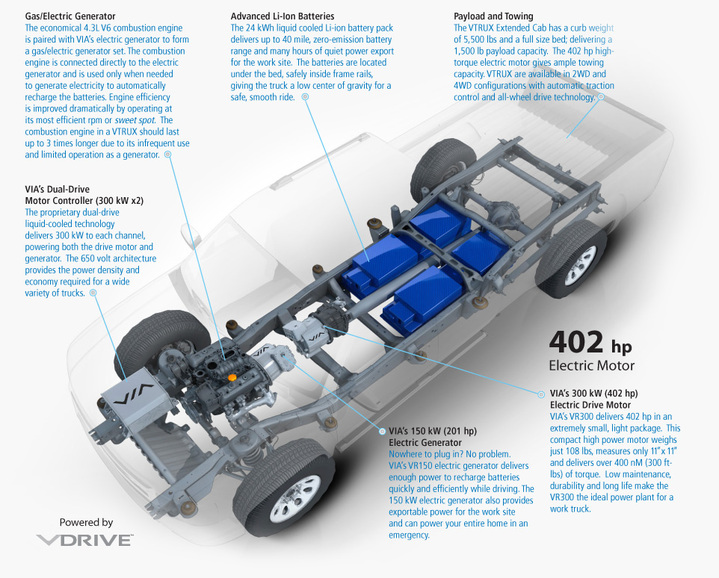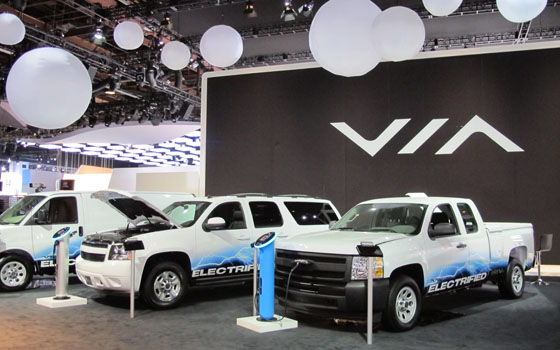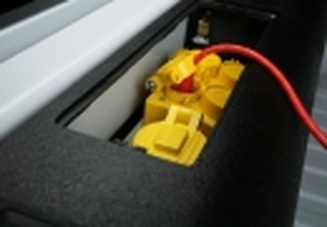
I am wondering how law enforcement, fire, ems, towing & utility companies could utilize this vehicle. My opinion is that it is a great concept, a generator could only help all of these first responder groups. Read the background & let me know what you think. Thank you!
Just because pickup trucks aren't taking center stage at the 2012 Detroit auto show doesn't mean there aren't enterprising companies looking to bring a better idea to the huge work truck market.
The people at Via Motors — which converts trucks into extended-range electric vehicles — believe they have a better idea, one that could become very important to the big U.S. truck makers and anyone else who might be considering a new truck in the future.
"We're going to start by staying focused on fleets and utility companies first, but who knows where this will go," said Kent Williams, founder and key player at Via Motors. "Basically, we've spent several years researching what the utility companies need from their vehicles ... and we think we have a pretty good package for them."
Via Motors, which is a newcomer to the North American International Auto Show, says its idea makes sense for fleets for now, but it could have implications for consumers in the future.
Via's booth housed three GM vehicles: one full-size heavy-duty van, one Chevy Silverado 1500 and one 2500 Suburban. Each was equipped with the eREV powertrain, which replaces the factory engine and transmission.
For simplicity's sake, you can imagine the eREV (which stands for extended range electric vehicle) to work exactly like the Chevy Volt. The vehicle runs on electricity but is equipped with a small gas engine that can charge the lithium-ion battery packs housed near the center and rear of the trucks.
The heart of the system is a pair of uniquely designed electric motors: a 300-kilowatt-hour motor for electric drive and a 150-kwh motor to charge the batteries and provide on-site exportable power for just about any need. The latter engine is one of the reasons why utility companies are interested in the technology, beyond the fact that the new powertrain can more than double a vehicle's fuel efficiency.
Each vehicle can be set up to accommodate specific needs, but the simple math goes like this: The vehicles will have a small V-6 engine — most likely the old and inexpensive existing 4.3-liter V-6 — that comes on only when the batteries need charging. (Optimum battery range is between 20 percent and 80 percent full). Range at full charge is likely to be around 40 to 50 miles on full electric power, and with a 25-gallon fuel tank (in some cases smaller than what it came with from the factory), the realistic range of the truck is likely to be about 350 miles, depending on how and where you drive. With a new regenerative braking system, the more city (stop-and-go) driving one does, the better the mileage gains.
We're told there's no reason why this technology has to be exclusive to any manufacturer, so Via Motors is just as ready to accommodate fleets that need Fords or Rams as it is to accommodate GM platforms.
As you might expect, pricing for the trucks is a bit high, with some costing about $40,000 extra for the technology change (which will also include an iPad-looking center console information station). That would bring the total price for the package (truck and powertrain swap) to just under $80,000. Clearly this technology is not quite ready for mass-market consumption, but for utility companies or big truck purchasers like Walmart, this could be an investment that saves big money over the long term.
We did a quick drive in a V-TRUX Silverado half-ton model, and there was quite a bit of normal EV high-frequency noise, but it was clearly not uncomfortable. Since there is no traditional transmission, there is no shifting, so the completely linear application of power was quite impressive to feel in a 5,000-pound vehicle.
The truck did have GM's four-wheel-drive system, and it does not require any modifications; the transfer case is bolted to the rear of the electric drive motor.
Preliminary zero-to-60-mph times are reported to be under 10 seconds, but the folks at Via tell us they can modify the software in the proprietary motor controller in any way the end user needs. So if you want your fleet drivers to keep it under 65 mph at peak fuel efficiency, they can program for that, but if you want more acceleration for merging into freeway traffic, they can dial quite a bit more off-the-line acceleration.
We're hoping to spend more time in one of the trucks to collect more impressions as Via tours the existing fleet to various utility companies. In the meantime, this could be a technology we (and maybe GM and Ford) will want to keep our eyes on. More to come.
By:


 RSS Feed
RSS Feed
